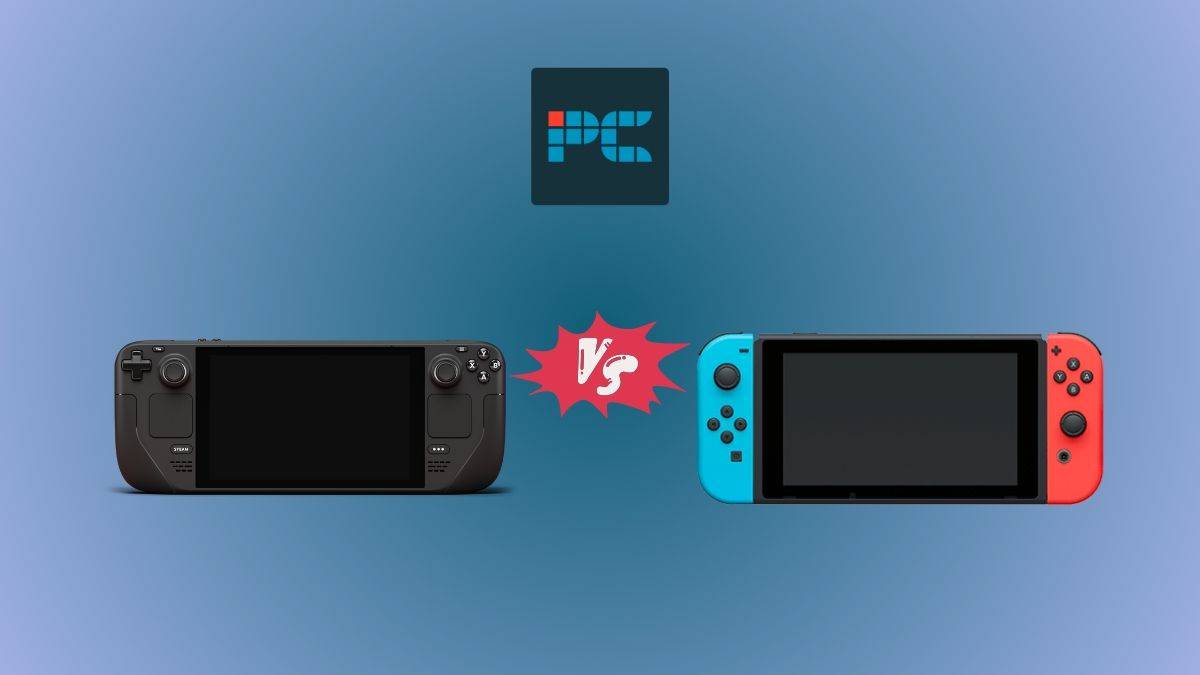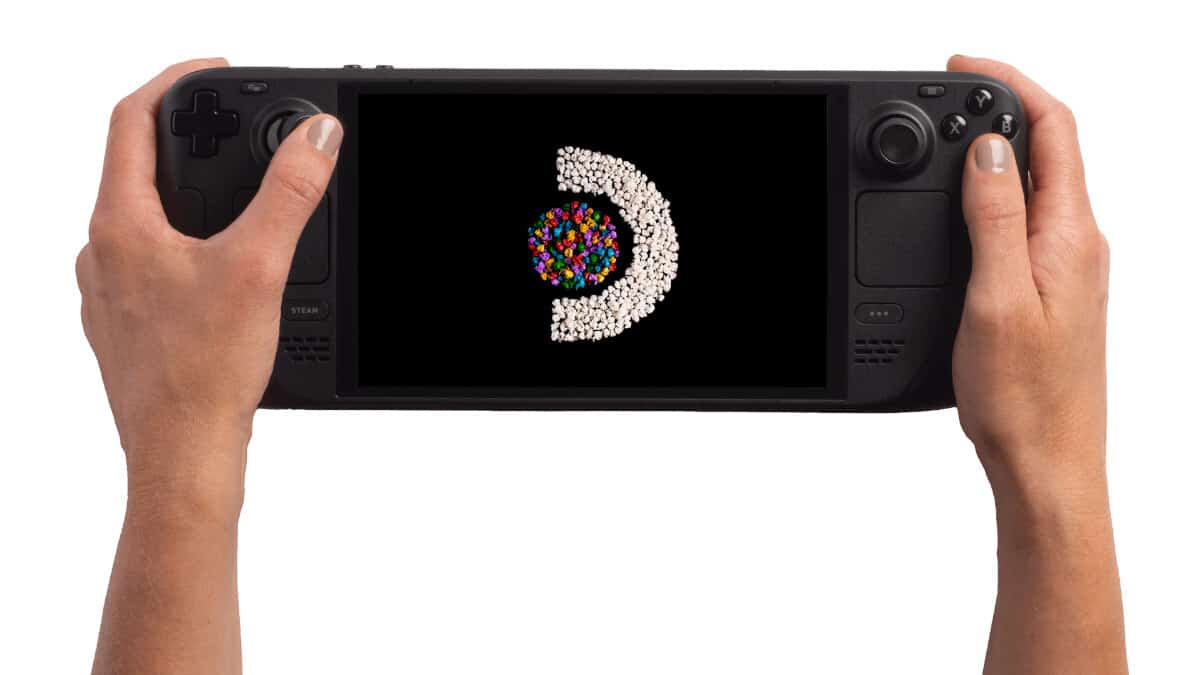Steam Deck vs Nintendo Switch – which is better?

Table of Contents
The release of the Nintendo Switch in 2017 completely transformed the console landscape, and in 2022 the Steam Deck pushed the boundaries of portable gaming even further: let’s see which handheld is better with a comparison of the Steam Deck vs Nintendo Switch. Has Valve’s Linux-based console got what it takes to knock the Switch from its pedestal as the most popular portable gaming device? With the recent release of a Steam Deck OLED, the device has certainly established itself as here to stay, and the market of pocket gaming PCs seems to only be growing.
When it comes to the handheld scene, the Switch has been a dominating force since it came out six years ago. However, as its hardware starts to age, it becomes more vulnerable to being overtaken by new competition. But does the Switch still have the edge over the Steam Deck? In this comparison article, we will break down the differences between these two handheld consoles, examining their specs, design, displays, battery life, gaming libraries, and price. Let's get started!
Prime Day may have closed its doors, but that hasn't stopped great deals from landing on the web's biggest online retailer. Here are all the best last chance savings from this year's Prime event.
- Sapphire 11348-03-20G Pulse AMD Radeon™ RX 9070 XT Was $779 Now $719
- AMD Ryzen 7 7800X3D 8-Core, 16-Thread Desktop Processor Was $449 Now $341
- Skytech King 95 Gaming PC Desktop, Ryzen 7 9800X3D 4.7 GHz Was $2,899 Now $2,599
- LG 77-Inch Class OLED evo AI 4K C5 Series Smart TV Was $3,696 Now $2,996
- AOC Laptop Computer 16GB RAM 512GB SSD Was $360.99 Now $306.84
- Lexar 2TB NM1090 w/HeatSink SSD PCIe Gen5x4 NVMe M.2 Was $281.97 Now $214.98
- Apple Watch Series 10 GPS + Cellular 42mm case Smartwatch Was $499.99 Now $379.99
- AMD Ryzen 9 5950X 16-core, 32-thread unlocked desktop processor Was $3199.99 Now $279.99
- Garmin vívoactive 5, Health and Fitness GPS Smartwatch Was $299.99 Now $190
*Prices and savings subject to change. Click through to get the current prices.
Steam Deck vs Nintendo Switch specs
| Specifications | Steam Deck LCD / Steam Deck OLED | Nintendo Switch / Nintendo Switch OLED |
|---|---|---|
| Display | – 7-inch LCD touchscreen – 7-inch OLED touchscreen | – 6.2-inch LCD – 7-inch OLED touchscreen |
| CPU architecture | – AMD Zen 2 | – ARM Cortex-A57 |
| Refresh rate | – 60Hz (LCD) – 90Hz (OLED) | – 60Hz |
| GPU architecture | – AMD RDNA 2 | – Nvidia Tegra X1 |
| GPU clock speed | – 1 – 1.6 GHz | – 307 – 768 MHz |
| RAM | – 16GB quad-channel LPDDR5 @ 5,500MT/s (LCD) – 6,400MT/s (OLED) | – 4GB LPDDR4 @ 1,600MT/s |
| Storage | – 64GB eMMC/256GB NVMe SSD/512GB NVMe SSD (LCD) – 512GB/1TB NVMe SSD (OLED) | – 32GB eMMC or 64GB eMMC |
| Native resolution | – 1280 x 800 | – 1280 x 720 |
| Battery size | – 5,313-mAh | – 4,310mAh |
Steam Deck vs Nintendo Switch features
Here, we will explore the features of both devices.
Displays: resolution and refresh rate comparison
When it comes to displays, the Steam Deck boasts superior specifications compared to the Nintendo Switch. With a resolution of 1280 x 800, the Steam Deck’s display surpasses the Nintendo Switch OLED’s 1280 x 720 screen. Additionally, the Steam Deck OLED model takes the lead with its OLED screen and a remarkable 90Hz refresh rate, offering a more vibrant and immersive gaming experience than its previous model.
On the other hand, both the original Nintendo Switch and the Steam Deck feature standard LCD screens with a 60Hz refresh rate. While these screens may not offer the highest quality visuals, they are still serviceable and capable of delivering enjoyable gameplay experiences. However, the hardware that’s powering up the screens is where you see the real difference between the consoles. The custom AMD APU Zen 2 and RDNA2-based graphics give the Steam Deck a huge advantage when it comes to speed and gaming performance, going above and beyond the capabilities of the Switch. While the Switch still performs amicably, its Nvidia Tegra X1 processor was first launched back in 2015, so naturally, over 8 years later the technology is no longer at the top of the game – in fact, it never really was.
Design
The Nintendo Switch, weighing a featherlight 397g with its Joy-Con controllers attached, was designed with portability in mind. Nintendo’s expertise in design ensured that the Switch feels light and comfortable, both in handheld mode and while docked. On the other hand, the Steam Deck weighs a substantial 669g, making it noticeably heavier. However, despite its size, the Steam Deck manages to retain the comfort of the Switch, thanks to its well-designed edges and curves that allow it to rest comfortably in your hands.
The extra space on the Steam Deck makes room for a pair of trackpad controls on the console front, four additional trigger buttons on the back, and a sufficient internal cooling system that’s matched up to the gaming power it’s capable of producing. So, while the Deck is bigger, it’s what people would call a bit more ‘hardcore’ than the Switch. This further demonstrates how the consoles are really targeted towards different gaming markets.
The Switch and the Switch OLED are designed with multiplayer gaming in mind, offering you docked, handheld, and tabletop modes that are friendly for both adults and kids. Additionally, while both consoles offer a docked mode, while the official dock comes included with the Switch, docking the Valve Steam Deck to your TV or monitor costs you an additional $90. In all, the Steam Deck is catered more toward PC gamers who prioritize playing their Steam games remotely, whereas the Switch is a bit more family-friendly.
Gaming Library
When it comes to gaming libraries, both the Steam Deck and the Nintendo Switch offer extensive options. The Steam Deck’s biggest advantage lies in its vast catalog, which includes decades of PC gaming history as well as upcoming games. With the Steam Deck, players have access to an almost limitless selection of games, spanning various genres and eras. As well as having native access to the extensive Steam Library, the Deck is a more open platform that’s excellent for emulation as well as playing some of the latest AAA titles.
On the other hand, the Nintendo Switch, while not matching the Steam Deck’s breadth of offerings, still boasts an impressive lineup of Switch games. Many first-party Nintendo games simply aren’t available on other gaming platforms, such as Legend of Zelda: Breath of the Wild, Animal Crossing, and Mario Kart, and a lot of these Nintendo Switch-only titles are the reason players are drawn to the console in the first place.
How many Nintendo Switch-exclusive games are there?
According to the Wikipedia page linked above which lists Nintendo Switch-only games, there are currently 171 titles that have been released exclusively on the Nintendo Switch and aren’t available on other platforms. However, this list of course might not reflect accurate changes, as new games are regularly released and older titles are often made cross-platform.
Battery life
When it comes to battery life, both the Nintendo Switch and the Steam Deck have their shortcomings. The Nintendo Switch has always struggled in this department, with its battery barely lasting a few hours out of the box. With just over 4000mAh inside, the Switch’s battery life is limited, making it challenging to enjoy extended gaming sessions without frequent charging; the Switch’s slow charging speed just further exacerbates this issue.
The Steam Deck, despite its impressive capabilities, also faces challenges in terms of battery life. While it offers a range of settings to optimize battery usage, it still falls short of providing extended playtime, mainly due to its powerful inner components. However, the launch of the Steam Deck OLED did see the battery of the console get bigger, showing that Valve is receptive to the concerns of gamers using the device.
Steam Deck vs Nintendo Switch price
The pricing of the Steam Deck and the Nintendo Switch is another crucial aspect to consider. The Nintendo Switch, being an older console, is generally more affordable than the Steam Deck. The various models of the Nintendo Switch are sold for $200 (Lite), $300 (Switch), and $350 (Switch OLED). On the other hand, the Steam Deck is sold for $399 (64GB), $529 (256GB), and $650 (512 GB), which although is more of an investment than the Switch, is more of a future-proof purchase with its improved hardware and expanding gaming library.
Is the Steam Deck better than the Nintendo Switch?
In the battle between the Steam Deck and the Nintendo Switch, the Steam Deck emerges as the victor. Its superior hardware, expanding gaming library, and potential for future upgrades make it an enticing choice for gamers seeking cutting-edge performance. While the Nintendo Switch revolutionized handheld gaming, the aging hardware and limitations of the platform now make it slightly less desirable in comparison, albeit for those exclusively seeking first-party Nintendo games.



